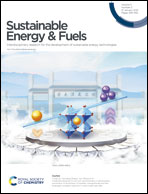The synergistic effect with S-vacancies and built-in electric field on a TiO2/MoS2 photoanode for enhanced photoelectrochemical performance†
Abstract
It is significant to design an electrode with high carrier separation and transport efficiency in a photoelectrochemical water splitting system. In this study, we utilized a facile H2O2 etching method for modulating S-vacancies in a TiO2/MoS2 nanostructure to enhance photoelectrochemical performance. The as-prepared TiO2/MoS2 with S-vacancies demonstrates an increased photocurrent density of 1.56 mA cm−2 at 1.23 V vs. RHE, which is 2.14 times higher than that of pristine TiO2 (0.73 mA cm−2 at 1.23 V vs. RHE). An appropriate energy level alignment between TiO2 and MoS2 and defect modulation are demonstrated in this study. The photo-generated electrons and holes are effectively separated and transported due to the built-in electric field in TiO2/MoS2. Moreover, the surface oxygen production reaction is enhanced due to its plenty exposed reaction active sites. This study demonstrates the synergistic effects of S-vacancies and built-in electric field in enhancing the carrier separation and transport properties. Furthermore, this study provides a universal strategy in designing high quality photoelectrodes in the photoelectrochemical system.



 Please wait while we load your content...
Please wait while we load your content...